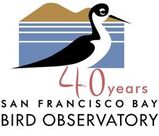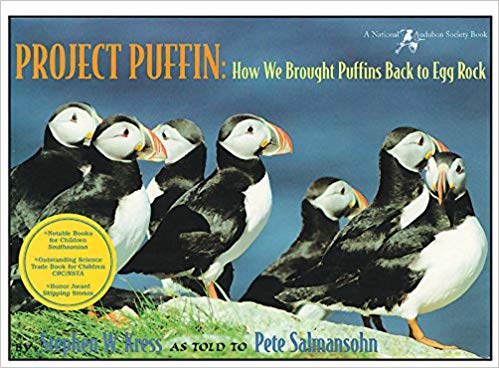|
By Guest Blogger Dudley Carlson
also an accessible version for young people, illustrated with photographs, in Project Puffin: How We Brought Puffins Back to Egg Rock (A National Audubon Society Book), by Stephen W. Kress as told to Pete Salmansohn (Tilbury House, 1997).
After sketching the reasons for the puffins’ disappearance from tiny Egg Rock, Kress describes the painstaking process by which chicks from a Newfoundland colony on Great Island, the largest puffin colony in North America, were taken to Egg Rock, introduced into burrows there, and fed daily until they were old enough to fledge and fly out to sea. Between 1973 and 1981, 954 chicks were introduced to Egg Rock. In 1981, the first chicks to return to breed there signaled the success of the experiment, and today there is a thriving colony. Kress describes a host of challenges: preventing predatory gulls from nesting on the island, creating puffin decoys to help attract returning birds, banding the chicks in order to identify them and monitor their success, and keeping records of the project in order to better understand the birds’ life cycle. The photos bring these charismatic birds to life, showing details such as the barbed roof of the mouth that makes it possible for them to carry many small fish at once. My trip was arranged by Bird Watcher’s Digest, which organizes several “Reader Rendezvous” each year. Hog Island, however, runs week-long camps all summer, some for adults and some for teenagers. If your teen has an ornithological bent, it’s a great learning experience in a beautiful spot. And of course with careful planning and some luck, you can see Tufted Puffins closer to home, at Año Nuevo State Park or Point Reyes. Better yet, learn more about banding birds at SFBBO’s banding events and at the Coyote Creek Field Station! SFBBO member Dudley Carlson, a biologist’s daughter, grew up in a family of birders and was Manager of Youth Services at Princeton (NJ) Public Library for 25 years. She believes that if children enjoy learning about birds and understand how important they are to our environment, then birds, nature and people will have a better chance at a healthy future.
0 Comments
Your comment will be posted after it is approved.
Leave a Reply. |
WingbeatWingbeat is a blog where you can find the most recent stories about our science and outreach work. We'll also share guest posts from volunteers, donors, partners, and others in the avian science and conservation world. To be a guest writer, please contact [email protected]. Archives
July 2024
Categories
All
|
San Francisco Bay Bird Observatory ● 524 Valley Way, Milpitas, CA 95035 ● 408-946-6548 ● [email protected]


 RSS Feed
RSS Feed